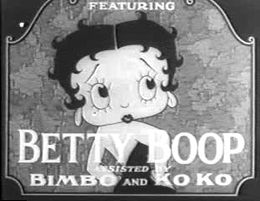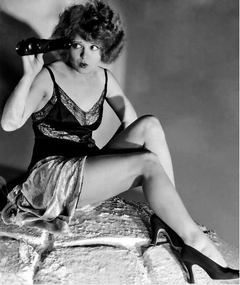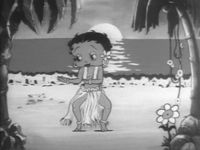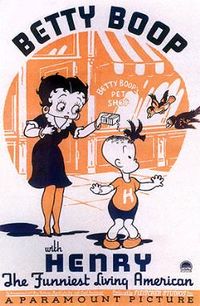Betty Boop

Betty Boop is an animated cartoon character created by Max Fleischer with contributions from animator Grim Natwick and others,[1][2][3][4][5][6] appearing in the Talkartoon and Betty Boop series of films produced by Fleischer Studios and released by Paramount Pictures. With her overt sexual appeal, Betty was a hit with filmgoers, and despite having been toned down in the mid-1930s, she remains popular today and became one of best known cartoon characters in world. She has been featured in two different comic strips, one in the 1930s and another in the 1980s.
Contents |
History
Origins

Betty Boop made her first appearance August 9, 1930 in the cartoon Dizzy Dishes,[5] the sixth installment in Fleischer's Talkartoon series. The character was modeled on superstar actress Clara Bow, the It-girl, whose sweet and seductive baby-doll looks was a well established marquee at the time. Bow kept her grip on her audience through the transition to sound, 1928/1929, and her muted but characteristic Brooklyn accent, singer Helen Kane, effectively caricatured. Also the choice of name for the cartoon, is built on Clara Bow's three syllable name. Betty Boop was originally created in the mode of an anthropomorphic French poodle.
Max Fleischer finalized Betty Boop as completely human by 1932 in the cartoon Any Rags. Her floppy poodle ears became hoop earrings, and her black poodle nose became a girl's button-like nose. Betty appeared in ten cartoons as a supporting character, a flapper girl with more heart than brains. In individual cartoons she was called "Nancy Lee" and "Nan McGrew", usually serving as a girlfriend to studio star Bimbo.
Betty's voice was first performed by Margie Hines, and was later provided by several different voice actresses including Kate Wright, Ann Rothschild (aka Little Ann Little), Bonnie Poe and most notably, Mae Questel, who began in 1931 and continued with the role until her death in 1998. Today Betty is voiced by Tress MacNeille and Tara Strong in commercials.

Although it has been assumed that Betty's first name was established in the 1931 Screen Songs cartoon Betty Co-ed, this "Betty" was an entirely different character. Though the song may have led to Betty's eventual christening, any references to Betty Co-ed as a Betty Boop vehicle are incorrect. (The official Betty Boop website describes the titular character as a "prototype" of Betty.) In all, there were at least 12 Screen Songs cartoons that featured either Betty Boop or a similar character. Betty appeared in the first "Color Classic" cartoon Poor Cinderella, her only theatrical color appearance (1934). In this film, she was depicted with red hair. In a cameo appearance in the feature film Who Framed Roger Rabbit (1988), in her traditional black and white, and voiced by Mae Questel, Betty mentioned that work had "gotten slow since cartoons went to color," but she has "still got it, boop oop a doop boop!"
Betty Boop became the star of the Talkartoons by 1932, and was given her own series in that same year beginning with Stopping the Show. From this point on, she was crowned "The Queen of the Animated Screen." The series was popular throughout the 1930s, lasting until 1939.
Betty as sex symbol

Betty Boop is known as the first and one of the most famous sex symbols on the animated screen;[7][8] she was a symbol of the Depression era, a reminder of the more carefree days of Jazz Age flappers. Her popularity was drawn largely from adult audiences, and the cartoons, while seemingly surrealistic, contained many sexual/psychological elements, particularly in the "Talkartoon", Minnie the Moocher, featuring Cab Calloway and his orchestra.
Minnie the Moocher is perhaps the one cartoon that defined Betty's character as a teenager of a modern era at odds with the old world ways of her parents. Betty is at odds with her parents and runs away from home, only to get lost in a haunted cave with her boyfriend Bimbo. A ghostly walrus (rotoscoped from live-action footage of Calloway), sings Calloway's famous song "Minnie the Moocher", accompanied by several other ghosts and skeletons. This haunting performance sends the frightened Betty and Bimbo back to the safety of home, sweet home. "Minnie the Moocher" served as a promotion for Calloway's subsequent stage appearances, and it also established Betty Boop as a cartoon star. The eight Talkartoons that followed all starred Betty, leading her into her own series beginning in 1932. With the release of Stopping the Show (August 1932), the Talkartoons were replaced by the Betty Boop series, which continued for the next seven years.[9]
Betty Boop represented a sexualized woman. Other female cartoon characters of the same period, such as Minnie Mouse, displayed their underwear or bloomers regularly, suggesting children or comical characters, not fully defined in a woman's form. Many other cartoon girls were merely clones of their male co-stars with alterations in costume, the addition of eyelashes and a female voice. Betty Boop wore short dresses, high heels and a garter belt. Her breasts were suggested with a low, contoured bodice that showed cleavage. (In Any Rags she looks out the window and her dress momentarily falls down revealing her cleavage.) In her cartoons, male characters tried to sneak peeks at her while she's changing or simply walking along minding her own business. In Betty Boop's Bamboo Isle, she does the hula topless, wearing only a lei and a grass skirt, which she repeated in her cameo appearance in the first Popeye cartoon, Popeye the Sailor (1933). Her "Bamboo Isle" performance was also included in the short Betty Boop's Rise to Fame, featuring a staged quasi-interview with studio head Max Fleischer.
There was, however, a certain girlish quality to the character. She was drawn with a head bigger than normal for an adult but normal for a baby. This suggested the combination of girlishness and maturity many people saw in the flapper type which Betty Boop was supposed to represent. While compromises on Betty's virtue were always a challenge, the animators kept her pure and girl-like, on screen, anyway. The studio's 1931 Christmas card featured Betty in bed with Santa Claus, winking at the viewer. Also in 1931, the Talkartoons The Bum Bandit and Dizzy Red Riding Hood were given distinctly "impure" endings. Officially, Betty was only 16 years old, according to a 1932 interview with Fleischer (although in The Bum Bandit [1] she's portrayed as a married woman with many children and also has an adult woman's voice, not the standard "boop-boop-a-doop" voice).
Attempts to compromise her virginity were reflected in Chess-Nuts (1932) and most importantly, Boop-Oop-A-Doop (1932). In Chess nuts, the Black King goes into the house where Betty is and ties her up. When she rejects him, he pulls her out of the ropes, drags her off to the bedroom and says, "I will have you". The bed, however, runs away and Betty yells out the window for someone to help her. Bimbo comes to her rescue and she is saved before anything happens. In Boop-Oop-A-Doop , Betty is a highwire performer in a circus. The villainous Ringmaster lusts for Betty as he watches her from below, singing "Do Something," a song previously performed by Helen Kane. As Betty returns to her tent, the Ringmaster follows her inside and sensually massages her legs, surrounds her and threatens her job if she doesn't submit. This is perhaps one of the earliest portrayals of sexual harassment on the screen, and was very daring at a time when such subject matter was considered taboo. Betty begs the Ringmaster to cease his advances, as she sings "Don't Take My Boop-Oop-A-Doop Away." Koko the Clown is outside of the tent, practicing his juggling and hears the struggle from inside the tent. He leaps in to save Betty's virtue, struggling with the Ringmaster who loads him into a cannon, firing it, thinking that he has sent the hero away, laughing with self-satisfaction. But Koko is hiding inside the cannon, and strikes the Ringmaster out cold with a mallet, returning with "the last laugh." When Koko expresses concern about Betty's welfare, she answers in song, "No, he couldn't take my boop-oop-a-doop away!"
Betty Boop's Big Boss (1933), however, wrong-foots the audience. After the usual menacing advances, there is a vast mobilization of outraged citizens, the Army, the Navy etc. to rescue Betty. The rescuers break in and discover Betty and the Big Boss happily embracing. The cartoon closes with astonished exclamations of disgust.

Helen Kane lawsuit
In May 1932, Helen Kane filed a $250,000 lawsuit against Max Fleischer and Paramount Publix Corporation for the "deliberate caricature" that produced "unfair competition" that exploited her personality and image. While Kane had risen to fame in the 1920s as "The Boop-Oop-A-Doop Girl" star of stage, recordings, and films for Paramount, her career was pretty much over by 1931. Interestingly, Paramount promoted the development of Betty Boop following Kane's decline. The case ended up dragging on for more than two years. As Kane's claims seemed on the surface to be valid, it was proven that her appearance was not unique, as both she and the Betty Boop character bore a resemblance to Clara Bow, another major Paramount star. However, the largest evidence against Miss Kane's case was her claims to the origins of her singing style. While an outgrowth of jazz "scat singing", testimony revealed that Kane had witnessed an African American performer, Baby Esther, using a similar vocal style in an act at the Cotton Club nightclub in Harlem some years earlier. An early test sound film was discovered of Baby Esther performing in this style, disproving Kane's claims.
Betty tamed
Betty Boop's best appearances are considered to be in the first three years due to her "Jazz Baby" character and innocent sexuality, which was aimed at adults. However, the content of her films was affected by the National Legion of Decency and the Production Code of 1934. The Production Code guidelines imposed on the Motion Picture Industry placed specific restrictions on the content films with references to sexual innuendo. This greatly affected the content of the films of Mae West at Paramount, as well as the Betty Boop cartoons until the end of the series.
No longer a carefree flapper, from the date the code went into effect (July 1, 1934), Betty became a husbandless housewife/career girl, wearing a fuller dress or skirt. Right from the start, Joseph Breen, the new head film censor, had numerous complaints. The Breen Office ordered the removal of the suggestive introduction which had started the cartoons up until now because Betty Boop's winks and shaking of her hips was deemed "suggestive of immorality." For a few entries, Betty was given a boyfriend, "Freddie," who was introduced in She Wronged Him Right (1934) and appeared in five more cartoons. Next, Betty was teamed with her cute puppy, "Pudgy", beginning with Little Pal (1934). The following year saw the addition of the eccentric inventor Grampy, who debuted in Betty Boop and Grampy (1935).
While these cartoons were tame compared to her earlier appearances, their self-conscious wholesomeness was aimed at more of a juvenile audience, which contributed to the decline of the series. Much of this decline was also due to the lessening of Betty's role in the cartoons in favor of her co-stars. This was a similar problem experienced during the same period with Walt Disney's Mickey Mouse, who was becoming eclipsed by the popularity of his co-stars Donald Duck, Goofy and Pluto, not to mention Fleischer's biggest success, Popeye.[10]
Being largely a musical novelty character, the animators attempted to keep Betty's cartoons interesting by pairing her with popular comic strip characters such as Henry, The Little King and Little Jimmy hoping to create additional spinoff series as with her pairing with Popeye in 1933. However, none of these films generated new series. While the period that Betty represented had been replaced by the big bands of the swing era, Fleischer Studios made an attempt to develop a replacement character in this style in the 1938 Betty Boop cartoon Betty Boop and Sally Swing, which was not a success.
The last "Betty Boop" cartoons were released in 1939, and a few made attempts to bring Betty into the swing era. In her last appearance, "Rhythm on the Reservation" (1939), she drives an open convertible labeled, "Betty Boop's Swing Band", while driving through a Native American reservation, where she introduces the people to swing music and creates a "Swinging Sioux Band." The Betty Boop cartoon series officially ended with one more 1939 entry, Yip Yip Yippy, which was actually a Boop-less one shot cartoon.
TV and DVD
In 1955, Betty's 110 cartoon appearances were sold to television syndicator UM&M TV Corporation, which was acquired by National Telefilm Associates (NTA) the following year. NTA was reorganized in the 1980s as Republic Pictures, which is presently a subsidiary of Viacom, the parent company owning Paramount. Ironically, Paramount, Boop's original home studio (via sister company Republic), now acts as theatrical distributor for the Boop cartoons they themselves originally released. Television rights are now handled by Trifecta Entertainment & Media, which in 2009 took over from CBS Television Distribution, successor to various related companies, including Worldvision Enterprises, Republic, and NTA.
The only exception to the above is Popeye the Sailor, which was sold to Associated Artists Productions with the rest of the Popeye cartoons. a.a.p. would eventually merge with United Artists Television, which itself became MGM/UA Television in 1981 as part of the merger between Metro-Goldwyn-Mayer and United Artists. MGM/UA's considerable library was bought by Turner Entertainment in 1986. Turner would merge with Time Warner 10 years later, and today, Turner/Warner Bros. holds the rights to Popeye the Sailor and all the rest of the a.a.p. and pre-1986 MGM library.
Betty Boop appeared in two television specials, The Romance of Betty Boop (1985) [11] and The Betty Boop Movie Mystery (1989) [12] and both specials are available on DVD as part of the Advantage Cartoon Mega Pack. She has made cameo appearances in television commercials and the 1988 feature film Who Framed Roger Rabbit. While television revivals were conceived, nothing materialized from these plans.
While the animated cartoons of "Betty Boop" have enjoyed a remarkable rediscovery over the last 30 years, official home video releases have been limited to the VHS and LaserDisc collector's set of the 1990s. In spite of continued interest, no official DVD releases have occurred to date (Lionsgate Home Entertainment, under license from Republic, owns the video rights to the Boop cartoons). Ironically, the image of Betty Boop has gained more recognition through the massive merchandising license launched by the heirs of Max Fleischer, with audiences today unaware of Betty's place in cinema and animation history.

Comic strips
The Betty Boop comic strip by Bud Counihan (assisted by Fleischer staffer Hal Seeger) was distributed by King Features Syndicate from 1934 through 1937. From 1984 through 1988, a revival strip with Felix the Cat, Betty Boop and Felix, was produced by Mort Walker's sons Brian, Neal, Greg and Morgan.[13]
Betty today
Betty Boop's films found a new audience when Paramount sold them for syndication in 1955. U.M.&M. and National Telefilm Associates were required to remove the original Paramount logo from the opening and closing as well as any references to Paramount in the copyright line on the main titles. However, the mountain motif remains on some television prints, usually with a U.M.&M. copyright line, while recent versions have circulated with the Paramount-Publix reference in cartoons from 1931. On the other hand, Popeye the Sailor was always shown with its original copyright line, as a.a.p. only removed the Paramount production logos from the Popeye cartoons, as well as title cards with the words "Paramount Presents" gracing the top.

The original "Betty Boop" cartoons were in black and white. And as newer product made for television began to appear, her cartoons were soon retired, particularly with the general proliferation of color television in the 1960s. But Betty's film career saw a major revival in the release of "The Betty Boop Scandals of 1974", and became a part of the post 1960s counterculture movement. NTA attempted to capitalize on this with a new syndication package, but there was no market for cartoons in black and white. As an answer, they had them remade cheaply in Korea, but were unable to sell them due largely to sloppy production that belied the quality of the originals. Unable to sell them to television, they assembled a number of the color cartoons in compilation feature titled, Betty Boop for President to capitalize on the 1976 election. But it saw no major theatrical release, and resurfaced in 1981 on HBO under the title, Hurray for Betty Boop.
It was the advent of home video that created an appreciation for films in their original versions, and Betty was rediscovered again in Beta and VHS versions. The ever expanding cable television industry saw the creation of American Movie Classics, which showcased a selection of the original black and white "Betty Boop" cartoons in the 1990s, which led to an eight volume VHS and LV set, "Betty Boop, the Definitive Collection." To date, no official DVD releases have been made in spite of the tremendous interest. In spite of this, there are currently 22 public domain Betty Boop cartoons available at the Internet Archive.
Marketers rediscovered Betty Boop in the 1980s, and "Betty Boop" merchandise has far outdistanced her exposure in films, with many not aware of her as a cinematic creation. Much of this current merchandise features the character in her popular, sexier form, and has become popular worldwide once again. The 1980s, rapper, Betty Boo (whose voice, image and name were influenced by the cartoon character) rose to popularity in the UK largely due to the "Betty Boop" revival.
There were brief returns to the theatrical screen. In 1988, Betty appeared after a 50 year absence with a cameo in the Academy Award-winning film Who Framed Roger Rabbit. In 1993, producers Steven Paul Leiva ("Space Jam") and Jerry Rees, best known for writing and directing The Brave Little Toaster, began production on a new Betty Boop feature film for The Zanuck Company and Metro-Goldwyn-Mayer. The script by Rees detailed Betty's rise in Hollywood in the Golden Age of Hollywood. It was to be a musical with music and lyrics by jazzman Bennie Wallace. Wallace had completed several songs and seventy-five percent of the film had been storyboarded, when, two weeks before voice recording was to begin with Bernadette Peters as Betty, the head of MGM, Alan Ladd, Jr., was replaced by Frank Mancuso, and the project was abandoned.
Ownership of the Boop cartoons has changed hands over the intervening decades due to a series of corporate mergers, acquisitions and divestitures (mainly involving Republic Pictures and the 2006 corporate split of parent company Viacom into two separate companies). As of 2008 and as forementioned, Lions Gate Home Entertainment (under license from Paramount) holds home video rights and Trifecta retains television rights. The "Betty Boop" character and trademark is currently owned by Fleischer Studios, with the merchandising rights licensed to King Features Syndicate.
The Betty Boop series continues to be a favorite of many critics, and the 1933 Betty Boop cartoon Snow White (not to be confused with Disney's 1937 film Snow White and the Seven Dwarfs) was selected for preservation by the U.S. Library of Congress in the National Film Registry in 1994. Betty Boop's popularity continues well into present day culture, with references appearing in the comic strip Doonesbury, where the character B.D.'s busty girlfriend/wife is named "Boopsie" and the animated reality TV spoof Drawn Together, where Betty is the inspiration for Toot Braunstein. A Betty Boop musical is in development for Broadway, with music by David Foster.
Betty was parodied on Animaniacs in "Girl With The Googily Goop", with the Boop character called "Googy". The episode, which was made predominantly in black-and-white and has not been released on DVD, is also a parody of Red Riding Hood, with the girl having to go to her grandma's house and ending up being kidnapped.
In 2010, Betty Boop became the official fantasy cheerleader for the upstart United Football League. She will also be featured in merchandise targeted towards the league's female demographic. [14]
Filmography (Betty Boop series)
Note: see the Talkartoons filmography for Betty Boop's earlier appearances, and see the Screen Songs filmography for additional Betty Boop's appearances.
1932 |
|
| Film | Original release date |
|---|---|
| Minnie the Moocher | 11 March |
| Stopping the Show | 12 August |
| Betty Boop's Bizzy Bee | 19 August |
| Betty Boop, M.D. | 2 September |
| Betty Boop's Bamboo Isle | 23 September |
| Betty Boop's Ups and Downs | 14 October |
| Betty Boop for President | 4 November |
| I'll Be Glad When You're Dead You Rascal You | 25 November |
| Betty Boop's Museum | 16 December |
1933 |
|
| Film | Original release date |
| Betty Boop's Ker-Choo | 6 January |
| Betty Boop's Crazy Inventions | 27 January |
| Is My Palm Read? | 17 February |
| Betty Boop's Penthouse | 10 March |
| Snow White | 31 March |
| Betty Boop's Birthday Party | 21 April |
| Betty Boop's May Party | 12 May |
| Betty Boop's Big Boss | 2 June |
| Mother Goose Land | 23 June |
| Popeye the Sailor | 14 July |
| The Old Man of the Mountain | 4 August |
| I Heard | 1 September |
| Morning, Noon and Night | 6 October |
| Betty Boop's Hallowe'en Party | 3 November |
| Parade of the Wooden Soldiers | 1 December |
1934 |
|
| Film | Original release date |
| She Wronged Him Right | 5 January |
| Red Hot Mamma | 2 February |
| Ha! Ha! Ha! | 2 March |
| Betty in Blunderland | 6 April |
| Betty Boop's Rise to Fame | 18 May |
| Betty Boop's Trial | 15 June |
| Betty Boop's Life Guard | 13 July |
| Poor Cinderella | 3 August |
| There's Something About a Soldier | 17 August |
| Betty Boop's Little Pal | 21 September |
| Betty Boop's Prize Show | 19 October |
| Keep in Style | 16 November |
| When My Ship Comes In | 21 December |
1935 |
|
| Film | Original release date |
| Baby Be Good | 18 January |
| Taking the Blame | 15 February |
| Stop That Noise | 15 March |
| Swat the Fly | 19 April |
| No! No! A Thousand Times No!! | 24 May |
| A Little Soap and Water | 21 June |
| A Language All My Own | 19 July |
| Betty Boop and Grampy | 16 August |
| Judge for a Day | 20 September |
| Making Stars | 18 October |
| Henry, the Funniest Living American | 22 November |
| Little Nobody | 18 December |
1936 |
|
| Film | Original release date |
| Betty Boop and the Little King | 31 January |
| Not Now | 28 February |
| Betty Boop and Little Jimmy | 27 March |
| We Did It | 24 April |
| A Song A Day! | 22 May |
| More Pep | 19 June |
| You're Not Built That Way | 17 July |
| Happy You and Merry Me | 21 August |
| Training Pigeons | 18 September |
| Grampy's Indoor Outing | 16 October |
| Be Human | 20 November |
| Making Friends | 18 December |
1937 |
|
| Film | Original release date |
| House Cleaning Blues | 15 January |
| Whoops! I'm a Cowboy | 12 February |
| The Hot Air Salesman | 12 March |
| Pudgy Takes a Bow-Wow | 9 April |
| Pudgy Picks a Fight! | 14 May |
| The Impractical Joker | 18 June |
| Ding Dong Doggie | 23 July |
| The Candid Candidate | 27 August |
| Service with a Smile | 23 September |
| The New Deal Show | 22 October |
| The Foxy Hunter | 26 November |
| Zula Hula | 24 December |
1938 |
|
| Film | Original release date |
| Riding the Rails | 28 January |
| Be Up to Date | 25 February |
| Honest Love and True | 25 March |
| Out of the Inkwell | 22 April |
| The Swing School | 27 May |
| The Lost Kitten | 24 June |
| Buzzy Boop | 29 July |
| Pudgy the Watchman | 12 August |
| Buzzy Boop at the Concert | 16 September |
| Sally Swing | 14 October |
| On With the New | 2 December |
| Thrills and Chills | 23 December |
1939 |
|
| Film | Original release date |
| My Friend the Monkey | 28 January |
| So Does an Automobile | 31 March |
| Musical Mountaineers | 12 May |
| The Scared Crows | 9 June |
| Rhythm on the Reservation | 7 July |
Feature film
In 1993 there were plans for an animated feature film of Betty Boop but those plans were later cancelled. The musical storyboard scene of the proposed film can be seen online.[16] The finished reel consists of Betty and her estranged father performing a jazz number together called "Where are you?". Jimmy Rowles and Sue Raney provide the vocals for Betty and Benny Boop.
Legacy
- In 2004, Betty Boop was voted among the 100 Greatest Cartoons in a poll conducted by the British television channel Channel 4, ranking at #96.
- In 2002, Betty was voted in TV Guide's 50 greatest cartoon characters of all time, ranking #17.
- In March, 2009, a UK newspaper voted Betty Boop the second sexiest cartoon character of all time, with Jessica Rabbit in first place and the Cadbury's Caramel Bunny in third.
References
Notes
- ↑ Fleischer, Richard (2005). Out of the inkwell: Max Fleischer and the animation revolution. University Press of Kentucky. p. 52. ISBN 9780813123554. "he, Max Fleischer, was the sole creator ... acknowledged that many animators contributed ... not just Natwick, but also Seymour Kneitel, Myron Waldman, ..."
- ↑ Kenner, Hugh; Jones, Chuck (1994). Chuck Jones: a flurry of drawings. University of California Press. p. 6. ISBN 9780520087972. "with the Max Fleischer people, ... creating Betty Boop"
- ↑ Yoe, Craig (2007). Clean Cartoonists' Dirty Drawings. Last Gasp. p. 10. ISBN 9780867196535. "great contribution ... Betty Boop, created for the Fleischer Studios."
- ↑ Worth, Stephen (3 November 2007). "Exhibit: Grim Natwick In New York". ASIFA-Hollywood Animation Archive. Los Angeles: ASIFA-Hollywood. http://www.animationarchive.org/2007/11/exhibit-grim-natwick-in-new-york.html. Retrieved 1 July 2009.
- ↑ 5.0 5.1 Cabarga, Leslie (1988). The Fleischer Story (Revised Edition ed.). New York: Da Capo Press. ISBN 0306803135. OCLC 17476938.
- ↑ "Myron Natwick, 100; Animated Betty Boop". The New York Times. Associated Press: p. B-24. 10 October 1990. http://www.nytimes.com/1990/10/10/obituaries/myron-natwick-100-animated-betty-boop.html. Retrieved 1 July 2009.
- ↑ Betty Boop - Boop Oop a Doop (1986) from Rotten Tomatoes
- ↑ Barboza, David (19 January 1988). "Video World Is Smitten by a Gun-Toting, Tomb-Raiding Sex Symbol". The New York Times: p. D3. http://query.nytimes.com/gst/fullpage.html?res=9504E1DF1238F93AA25752C0A96E958260. Retrieved 1 July 2009.
- ↑ Variety
- ↑ http://findarticles.com/p/articles/mi_g1epc/is_tov/ai_2419100117?hblstpn=search_sampler&lstpc=search&lstpr=external&lstprs=other&lstwid=1&lstwn=search_results&lstwp=body_middle
- ↑ The Romance of Betty Boop at the Internet Movie Database
- ↑ The Betty Boop Murder Mystery at the Internet Movie Database
- ↑ Strickler, Dave (1995). Syndicated Comic Strips and Artists, 1924–1995: The Complete Index. Cambria, Calif.: Comics Access. ISBN 0-9700077-0-1. OCLC 33053636.
- ↑ http://uflaccess.com/ufl/ufl-pr-betty-boop-official-fantasy-cheerleader-of-ufl/
- ↑ Mackey, Dave (10 May 2009). "Fleischer Sound Cartoons Filmography". http://www.davemackey.com/animation/fleischer/. Retrieved 1 July 2009.
- ↑ http://www.moorestudiosinc.com/bettyboop.htm
Bibliography
- Solomon, Charles (1994). The History of Animation: Enchanted Drawings. Outlet Books Company.
- Betty Boop: The Definitive Collection, Volumes 1-8 (VHS)
External links
- Betty Boop's site
- Links to all Betty Boop cartoons on Internet Archive and YouTube
- List of Public domain Betty Boop cartoons online
- Betty Boop on Vintage ToonCast
- Betty Boop Festival Wisconsin - Animator Grim Natwick's hometown
- Betty Boop Eyegate Gallery
|
||||||||
|
|||||||||||||||||